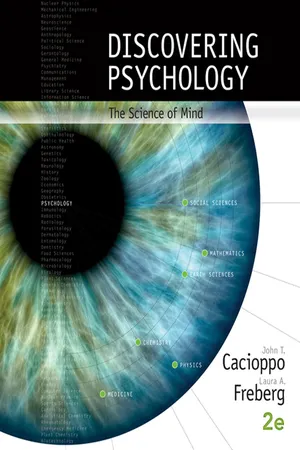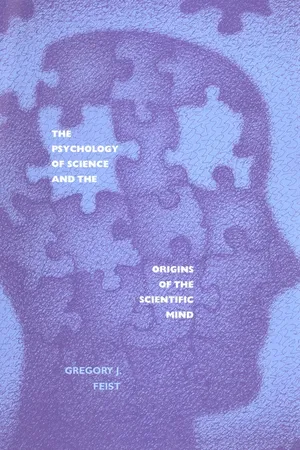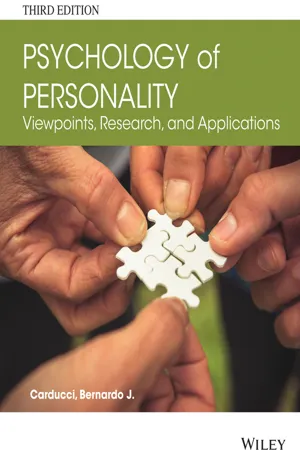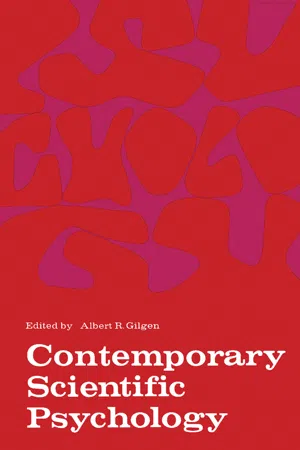Psychology
Biological Approach
The biological approach in psychology focuses on understanding behavior and mental processes through the lens of biology, genetics, and the nervous system. It emphasizes the role of genetics, brain structure, neurotransmitters, and hormones in shaping human behavior and psychological processes. This approach seeks to uncover the biological underpinnings of psychological phenomena.
Written by Perlego with AI-assistance
Related key terms
1 of 5
10 Key excerpts on "Biological Approach"
- eBook - ePub
- Nancy Fenton, Jessica Flitter, Jessica Flitter(Authors)
- 2015(Publication Date)
- Research & Education Association(Publisher)
Chapter 5 Biological Bases of BehaviorBiological psychology can be traced to the beginnings of psychology because it has its roots in physiology. The field of biological psychology , also called neuroscience , focuses on how genes, the nervous system, and the endocrine system influence behaviors and mental processes. Technological advances have allowed biological psychologists to provide a more complete understanding of what occurs on a physiological level during a psychological experience such as thinking or memory.Heredity, Environment, and EvolutionAn important aspect of the study of psychology is the interplay among genetic, environmental, and evolutionary influences. Complex human traits, such as intelligence, aggression, altruism, and personality, are influenced by all of these factors. For instance, psychologists attempt to determine how an individual’s level of aggression is impacted by inheritance and exposure to violence, as well as why aggressive tendencies were naturally selected.Biologists and psychologists are both interested in the various influences of nature and nurture on human traits. Biologists study physical traits, such as height and eye color, or susceptibility to diseases, such as cancer. In contrast, psychologists are interested in behavioral traits and psychological illnesses. Behavioral traits include aggression, intelligence, personality, etc.; psychological illnesses include anxiety, schizophrenia, depression, etc. The scientific discipline of behavioral genetics attempts to integrate the influences of heredity, environment, and evolution in terms of their effect on human behavior.HeredityBiological psychologists are interested in the study of heredity, or how the traits of parents are transmitted biologically to offspring. The nucleus of each human cell contains forty-six chromosomes , twenty-three donated by each parent. Chromosomes that determine gender are known as the X and Y chromosomes . One X chromosome is donated by the mother, and either an X or Y chromosome is donated by the father. An XX individual is female; an XY person is male. Each chromosome contains genes , which are made up of a chainlike molecule called deoxyribonucleic acid (DNA) . Each individual gene can be either dominant or recessive. A dominant gene takes precedence over a recessive gene for that particular trait. For the gene that determines eye color in humans, brown is the dominant gene and blue is the recessive gene. If either parent donates a dominant gene for eye color, the child will have brown eyes. If both parents donate recessive genes for eye color, the child will have blue eyes. A Punnett square can be used to predict the outcome of various traits. The genotype is the genetic makeup for a trait in an individual, which may or may not be expressed, while the observable characteristics of genes are referred to as the phenotype - eBook - PDF
Discovering Psychology
The Science of Mind
- John Cacioppo, Laura Freberg(Authors)
- 2015(Publication Date)
- Cengage Learning EMEA(Publisher)
While investigating a particular behavior, the biological psychologist focuses on links between observed behavior and genetic factors, biochemical factors, and the activity level and structural characteristics of the nervous system. These links do not travel in one direction only, such as from biologi-cal factors to behavior, but are more accurately viewed as reciprocal. For example, we know that if you administer extra testosterone to human males, raising their testosterone so that AP Images/Matt Slocum Chapter 4 | THE BIOLOGICAL MIND: THE PHYSICAL BASIS OF BEHAVIOR Copyright 2016 Cengage Learning. All Rights Reserved. May not be copied, scanned, or duplicated, in whole or in part. Due to electronic rights, some third party content may be suppressed from the eBook and/or eChapter(s). Editorial review has deemed that any suppressed content does not materially affect the overall learning experience. Cengage Learning reserves the right to remove additional content at any time if subsequent rights restrictions require it. WHAT IS BIOLOGICAL PSYCHOLOGY? 107 it is above a normal level, they are likely to behave more aggressively (Pope, Kouri, & Hud-son, 2000). In this case, biology (raising testosterone levels) is influencing behavior (aggres-sion). However, we also know that watching his favorite sports team lose lowers a man’s testosterone level (Bernhardt, Dabbs, Fielden, & Lutter, 1998). Here, we see the influence of behavior (supporting a particular team and watching the team lose) on biology (testoster-one level). Early Attempts to Understand Biological Psychology Advances in the methods we use to observe the structure and function of the nervous system have driven the history of biological psychology. The discovery of contemporary methods, such as the recording and imaging of brain activity, opened new areas of inquiry to biological psychologists. - eBook - PDF
Psychology
Six Perspectives
- Dodge Fernald(Author)
- 2007(Publication Date)
- SAGE Publications, Inc(Publisher)
3 Biological Psychology Origins of Biological Psychology Wundt and Physiology Changing Views of the Brain Basic Research Methods The Nervous System Interlocking Systems Structure of Neurons Neurotransmitters and Drugs Organization of the Brain Maintaining Internal Conditions Responding to External Events The Limbic Connection The Cerebral Cortex Primary and Association Areas Concept of Localization Modern Biomedical Therapy Assessment and Diagnosis Guidelines for Treatment Commentary and Critique 49 B iological psychology is a useful starting point in the study of behavior. All human and animal activities emerge from underlying biological mechanisms. Focusing on the nervous system, especially the brain, biologi-cal psychology examines the ways the organs of the body influence behavior and experience. In the 17th century, René Descartes greatly advanced the dawn of bio-logical psychology through his inquiry into natural philosophy, meaning a systematic study of nature, especially animal physiology, which was pursued chiefly through dissections. In this way he studied animals and human beings in terms of a machine metaphor. In animals, the mechanical parts were simpler and were activated by a special fluid, which Descartes called animal spirits. In human beings, some mysterious, immaterial substance played a loftier role, for human mental life seemed to be separate from bodily activ-ity. In one way or another, the machine metaphor of the body endured until the contemporary focus on the brain prevailed. After further comments on the origins of biological psychology, this chapter turns to modern views of the nervous system, organization of the brain, and details of the cerebral cortex. It closes with a discussion of men-tal disorders and biomedical therapy, followed by a commentary and cri-tique of the biological perspective. - eBook - ePub
- G Neil Martin(Author)
- 2015(Publication Date)
- Routledge(Publisher)
Histology is the study of brain cells and their structure and activity. You will learn more about the study of cells later on in Chapter 2 and in the chapters on neuroanatomy and neurotransmission. Finally, psychoneuroimmunology refers to the study of the body's immune system processes and the ways in which they react to psychological variables. Psychoneuroimmunologists may, for example, look at the effect of stress on wound healing, the development of an illness or on the maintenance of good health; they may study variables that mediate these effects, such as sex, age, personality, ability to cope, and so on. All of these sub-areas – in themselves, large areas of study – come under the umbrella of biological psychology. 1.3 Biological Psychology's Approach to Behaviour Like all sciences, biology, psychology and biological psychology have their roots in the philosophy of the Ancient Greeks and were fashioned by the various philosophical schools of thought that developed from this. At the heart – and, indeed, the brain – of biological psychology is a phenomenon called reductionism (or biological reductionism). 1.4 Reductionism Reductionism refers to the idea that the subject matter of science can best be understood by reducing it to its smallest parts. Biological reductionism argues that we can only understand biological processes by looking at the physical components and mechanisms that give rise to these. Applying this approach to biological psychology, the prevailing view is that an organism's behaviour can best be understood – some biological psychologists argue, can only be understood – by studying the biological basis of behaviour. In effect, you are reducing the study of behaviour to its most basic building blocks: the cells, organs, systems and brain regions that give rise to behaviour - eBook - ePub
- (Author)
- 2012(Publication Date)
- Wiley(Publisher)
Chapter 3 Biological Psychology Robert E. Clark, Jena B. Hales, Stuart M. Zola, and Richard F. Thompson The Mind The Brain Sensory Processes Learning and Memory Motivation and Emotion Cognitive Neuroscience Conclusion ReferencesThe great questions of philosophy, the mind–body problem and the nature of knowledge, were also the questions that drove early developments in the pathways to modern psychology. This is especially true of biological or physiological psychology. Wilhelm Wundt, who founded experimental psychology, titled his major work Foundations of Physiological Psychology (1874/1908). William James, the other major figure in the development of modern psychology, devoted a third of his influential text Principles of Psychology (1890) to the brain and nervous system. Both Wundt and James studied medicine and philosophy, and both considered themselves physiologists. Their goal was not to reduce psychology to physiology but rather to apply the scientific methods of physiology to the study of the mind. The other driving force in early biological psychology was the study of the brain and nervous system.The major topics in modern biological psychology are sensory processes, learning and memory, motivation and emotion, and, most recently, cognition—in short, behavioral and cognitive neuroscience. A number of other areas began as part of physiological psychology and have spun off to become fields in their own right. We treat the major topics in biological psychology separately in the text that follows. But first we sketch very briefly the recent philosophical and physiological roots.The Mind
The history of such issues as the mind–body problem and epistemology is properly the domain of philosophy, treated extensively in many volumes and well beyond the scope of this chapter and the expertise of these authors. Our focus in this brief section is on the history of the scientific study of the mind, which really began in the 19th century. - Claude E. Buxton(Author)
- 2013(Publication Date)
- Academic Press(Publisher)
12 Biological Contributions to the Development of Psychology KARL H. PRIBRAM AND DANIEL N. ROBINSON INTRODUCTION This chapter concerns several important influences that biology has had on the development of psychology as a science. Specifically, we attempt to account for an apparent paradox: In the nineteenth century, rapid advances were made in relating biology in general and brain func-tion in particular to the phenomena of mind. Throughout much of the first half of the twentieth century, however, these same relationships were all but ignored and the foundations for a scientific psychology were sought in the environment. The biological aspects of psychology, perhaps more than other special branches of the discipline, resist historical compression. Psychobiology, as we shall call the subject, 1 is deeply rooted in both philosophy and 1 There is still no universally accepted criterion for distinguishing among the terms physiological psychology, psychobiology, neuropsychology, and biopsychology. A grow-ing convention would reserve the term neuropsychology to theory about the human nervous system based on research involving complex cognitive processes, often in settings in which clinical findings are directly relevant. Physiological psychology strikes many as too restricted, for much current work falls under headings such as biophysics, computer science, or microanatomy that are synonymous with physiology. Thus, psychobiology is used here to refer to the broadest range of correlative studies in which biobehavioral investigations are undertaken and referenced to phenomenal experience. POINTS OF VIEW IN THE MODERN HISTORY OF PSYCHOLOGY 345 Copyright © 1985 by Academic Press, Inc. All rights of reproduction in any form reserved. ISBN 0-12-148510-2 346 Karl H. Pribram and Daniel N. Robinson biological science and was the subject of speculative and experimental psychology 2 centuries before Wundt christened the Leipzig laboratory (1874).- Gregory J. Feist(Author)
- 2008(Publication Date)
- Yale University Press(Publisher)
The more we understand of genetics and neuroscience, the more we come to see the power of the environment in molding and shaping our biological systems, most promi-nent of which are genes, neurons, and brain structures. The flexibility of hu-mans to learn virtually whatever our environment throws at us may be related to such genetic and neural malleability and may be, when all is said and done, the signature trait of the human species. 1 The study of scientists per se is not required for a biological psychology of science, for much of scientific thinking is in fact implicit and stems from basic neuroscientific processes. The “implicit biological psychology of science” is in-deed a rich and exploding domain of investigation due mostly to its connection with two major revolutions in science over the last ten to fifteen years, namely, genetics and neuroscience. To be clear: the genetic and neuroscientific founda-tions of human thought are not specific to scientific thought. But specific do-mains of mind (especially the social, physical, natural-historical-biological, and mathematical domains) are the origins of the systematic and formal physical, biological, and social sciences that exist today (see part ). To the extent that current genetic and neuroscientific research sheds light on these cognitive facil-ities, they shed light on foundations of higher human cognitive functioning, including scientific reasoning, problem solving, and creativity. BEHAVIORAL GENETICS AND INTELLIGENCE Behavioral genetics is the best method for acquiring knowledge of the genetic basis of intelligence and behavior.- eBook - PDF
Psychology of Personality
Viewpoints, Research, and Applications
- Bernardo J. Carducci(Author)
- 2015(Publication Date)
- Wiley(Publisher)
The behavioral genetics viewpoint rep- resents the examination of the extent to which differences in the expression of personality are determined by genetics and envi- ronmental factors. In this chapter we will discuss the basic ideas, methodological considerations, major findings, and some of the applications of the behavioral genetics viewpoint. We begin by surveying some basic issues related to examining biological pro- cesses in the study of personality. 288 Chapter 8 The Behavioral Genetics Viewpoint Biological Processes in the Study of Personality: Some Basic Issues The scientific perception of the role of biological pro- cesses in the study of personality has a long and rich history, dating back to some of the earliest views of personality. We will begin our discussion of these bio- logical processes by examining some of the basic issues associated with the biological viewpoints of personal- ity. These include the nature-nurture controversy, the significance of heredity, limitations of genetic explana- tions of behavior, the logic of the biological viewpoint, and the biosocial interaction. The Nature-Nurture Controversy: An Evolving Issue A basic issue surrounding the biological perspective of personality—one that is evolving—is the nature- nurture controversy (Krueger & Johnson, 2008; Morf & Ayduk, 2005; Pervin, 2002). In its most fundamental form, the nature-nurture controversy concerns the extent to which personality and other complex behaviors are determined by biological versus envi- ronmental factors. On the nature side of the argument is the assumption that various inherited biological factors (e.g., hormones and genetics) are the principal determinants of personality. - eBook - PDF
- Sandra Goss Lucas(Author)
- 2009(Publication Date)
- Wiley-Blackwell(Publisher)
76 Biological Psychology Chapter 5 Biological Psychology Getting Started One of the challenges of this unit is deciding where to locate it within your course. It must be presented early enough so that stu-dents can use this knowledge in future chapters, but not so early that students cannot see the relevance of the information. It is tempting to just lecture about biological psychology, provid-ing students with, essentially, an anatomy lesson. However, it is vital that you find activities to keep students engaged. Active learning will ensure that they understand the concepts and it will keep them from getting bored or overwhelmed by the material. I focus on why this material is important since many students see it as being irrelevant to psychology. I relate biological functions to future chapters (mental illness, learning, cognition, etc.) and then I make sure that I refer back to the relevant biological concepts in those future units. I talk about how advances in brain imaging have led to a greater understanding of biology’s impact on psychological disorders as well as basic human functions such as sleep, eating, and learning. Biological psychology is central to understanding the rest of psychology. My second focus is to stress the nature/nurture interaction. I want students to understand that the environment has an impact on Biological Psychology 77 the brain—the brain is not a static entity, impervious to influence. Nurture does have an impact on nature as well as nature influencing nurture. I use more visuals in this unit than any other. Visuals help students see the brain structures and graphics of processes (e.g., neurotrans-mission) often clarify complicated information. And don’t forget that students need to have access to these visuals either through a web site or through handouts—they should not have to spend class time trying to draw the brain as you talk. My outline for teaching (2 1 / 2 days—75 minute classes) Day 1 ( 1 / 2 day) I. - eBook - PDF
- Albert R. Gilgen(Author)
- 2013(Publication Date)
- Academic Press(Publisher)
Part II THE RESEARCH AREAS This page intentionally left blank The Biology of Mind: Neurobehavioral Foundations 1 KARL H. PRIBRAM DEPARTMENTS OF PSYCHIATRY AND PSYCHOLOGY STANFORD UNIVERSITY STANFORD, CALIFORNIA I. What Psychology Can Be About 45 II. Minding Brain Facts 47 III. The Experimental Analysis of Mind 51 IV. A Difference That Makes a Difference 57 V. Of Interdisciplinary Endeavors 59 VI. The Language of the Brain 61 VII. The Emergence of Biological Rationalism 65 References 67 I. W H A T PSYCHOLOGY CAN BE ABOUT I have been asked to describe here my systematic approach to problems in psychology. At first this seemed a reasonable request, easily met since my experimental work has progressed in a fairly systematic fashion and my lectures to students of psychology seemed not unduly chaotic. A closer review provoked by an undergraduate student who asked simply what is 1 This paper was presented in part as the Presidential Address to the Division of Physiological and Comparative Psychology, American Psychological Association, San Francisco, September, 1968. The research was supported by NIMH Grant MH 12970 and USPHS Career Award MH 15,214. 45 46 KARL Η. PRIBRAM the basic tenet of your system?, made me realize that my approach was not nearly as rigidly forethought as I had suspected. I had not cooly fashioned a model—on the contrary, much healthy intuition, guesswork, groping, and fortuitous circumstance went into what might be called my position. In fact I was hard put to come up with any one central tenet. What I can present, however, is a central tenet at each level of inquiry to which my interests are directed. Let me begin at the top, the most general level of scientific inquiry, then illustrate the operations by which I implement this approach, and finally present some of my views of brain function and of the psychological process which have resulted from such implementation.
Index pages curate the most relevant extracts from our library of academic textbooks. They’ve been created using an in-house natural language model (NLM), each adding context and meaning to key research topics.









